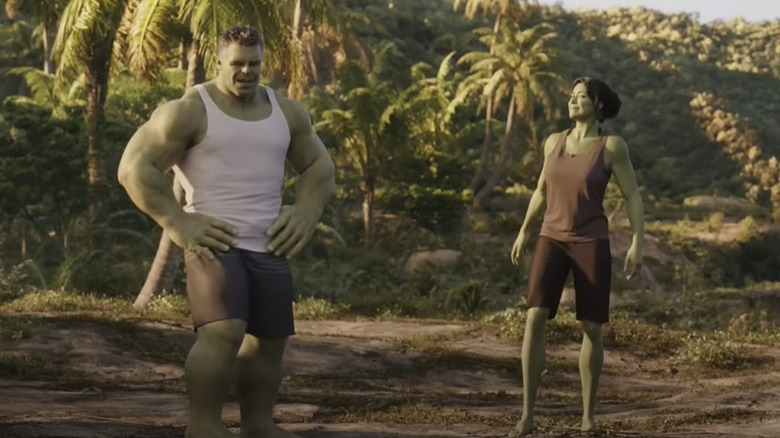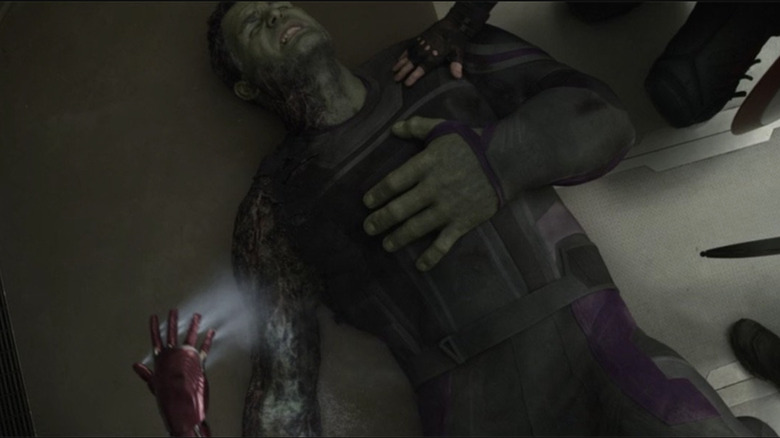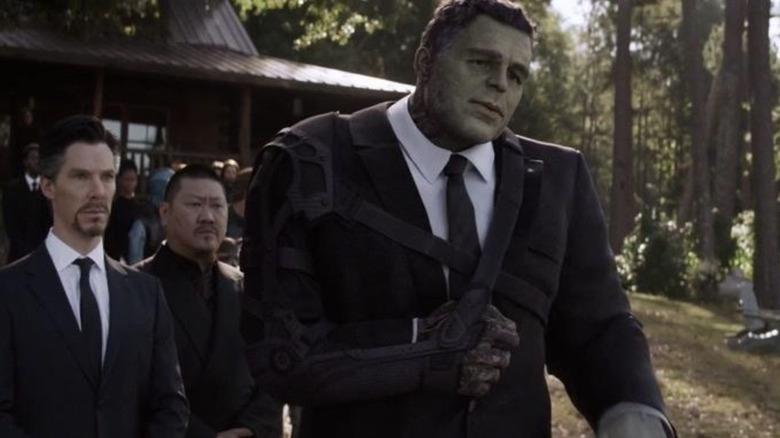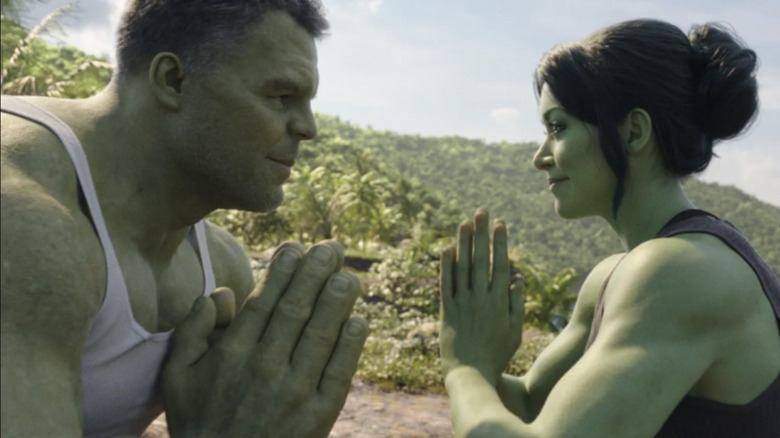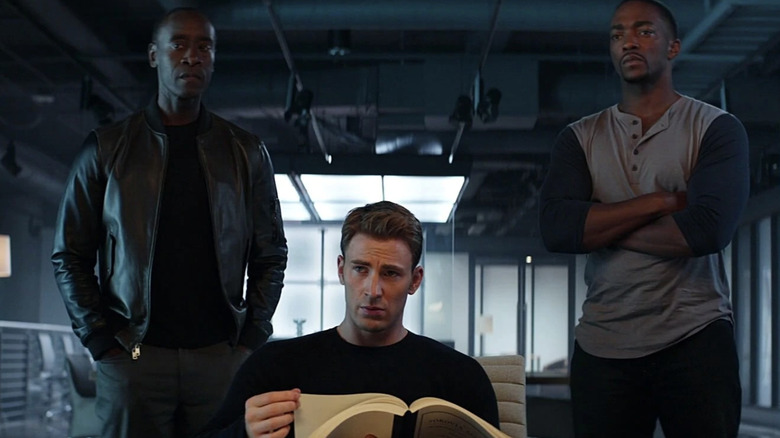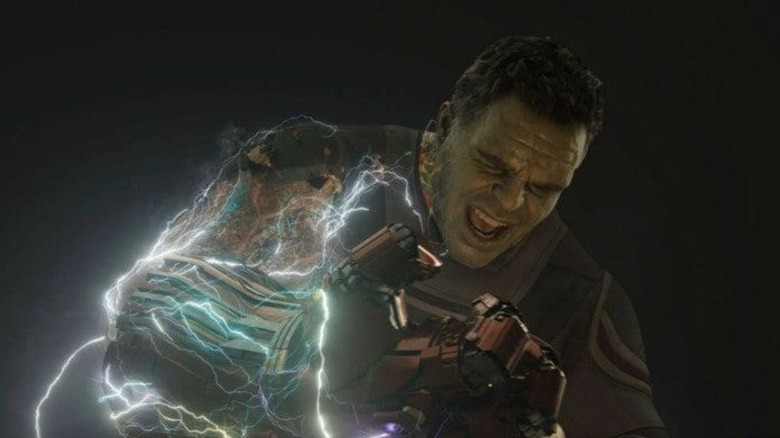She-Hulk Proves The MCU Is Starting To Have A Major Comic Book Problem
"She-Hulk: Attorney at Law" is the latest Marvel Cinematic Universe Disney+ show to grace our televisions, but it won't be the last. Building up to the end of Phase 4 of the MCU, "She-Hulk" provides a comedic and lighthearted take on Jennifer Walters. The cousin of the Hulk, Jennifer, becomes a hulk herself after receiving a healthy dose of Bruce Banner's blood following an accident. Part legal comedy and part superhero show, "She-Hulk" looks to introduce a new corner of the MCU, with Walters taking on all sorts of superhuman cases bringing in heroes and villains both old and new.
With all of these superheroes continuing to come out of the woodwork comes a slew of new problems for Feige and the team at Marvel Studios to handle. With no end in sight and the projects getting more prominent, the MCU seems to be heading towards the beaten-down path that their source material is still on to this day: that of no lasting consequences. The first episode of "She-Hulk" is a testament to the series of films and shows going back to the status quo for the sake of more convenient storytelling, and one that, if not changed, could lead the MCU to become staler than it already is.
Spoilers for the first episode of "She-Hulk" follow!
A lack of consequences
"She-Hulk" opens with Bruce Banner in human form and with a cast, similar to his appearance in "Shang-Chi and the Legend of the Ten Rings." Still weakened by his use of the Infinity Gauntlet in "Avengers: Endgame," Bruce is injured in a car accident while in human form, leading to his blood coming into contact with an open wound on Jennifer, who was driving the car. Thus, She-Hulk is born. This itself isn't a problem, but when She-Hulk awakens in a lab built by Bruce and Tony Stark, she finds a Smart-Hulk completely healed from the damage done by the infinity gauntlet in "Endgame."
The healing process is done offscreen, with a simple explanation given that Jennifer's hulk blood has a special property that provided a way for Bruce to become whole again. The reversal of his injuries is done so that he could have an entertaining training montage with Jennifer, but the execution feels unconcerned about how it gives the MCU a feeling of having no stakes; a lack of consequences leading to stories that won't be as interesting because of it. Up to this point, the MCU has gotten audiences invested in its characters by providing real growth and development.
From Tony Stark's sacrifice to Steve Rogers choosing to retire, there was a real sense of closure surrounding "Avengers: Endgame." Unfortunately, the creative decision of healing Hulk contradicts those sacrifices and feels eerily similar to something you would read in a Marvel comic book.
Irreparable damage becomes reparable
Marvel comics, and comics from the big publishers as a whole, have a way of making significant changes to characters, followed by resetting them in time for the next first issue. Captain America dies in a landmark issue? No, that bullet actually sent him back in time, so he'll be back when his series relaunches with a new #1 issue in a year. Iron Man becomes evil in a new series? He's back to being the Iron Man you knew in six months or less. The cyclical nature of comic books that always returns to the status quo is expected from comics, but a film series is entirely different.
Hulk's previous big appearance in the MCU set a precedent: back-to-back "Avengers" films that saw the team push themselves to their absolute limit to stop Thanos. Previously, the Russos had spoken to CinemaBlend regarding the damage the gauntlet does to its user, calling it "irreversible."
"He's lost an arm. He lost Natasha. That's not coming back. He's damaged himself. I don't know. It's interesting. That's permanent damage, the same way that it was permanent damage with Thanos. It's irreversible damage. His arm, if you noticed, is a lot skinnier. It's blackened. So, he loses a lot of strength there."
Balancing two Hulks
The idea of Hulk living with a constant reminder of his choice in "Endgame" is powerful. Unfortunately, there was no way to see the character living with those repercussions long enough for it to matter. A prominent appearance by Bruce Banner in another project before this would have made the pill easier to swallow; unfortunately, that isn't the case. The release format of these shows and lack of flexibility with certain character appearances are also to blame for the lead-up to the return of Smart-Hulk being as anti-climactic as it ended up being.
It's understandable that "She-Hulk" needed to bring Bruce Banner back to give Jennifer Walters a guide in its earlier episodes, but doing so at the cost of providing stakes in the Marvel universe may not have been the best route to take. Moreover, having She-Hulk being the one to fill the void left by Bruce's sacrifice of his arm in "Endgame" is just one of many routes the series and the MCU as a whole could have taken to amend the need of having Bruce in the show. Alas, the route that ended up being taken involves two Hulks at the top of their game, lessening the stakes while upping the number of heroes in the MCU.
While this isn't a big issue on its own, this wouldn't be the first time the MCU backed out of having long-lasting consequences.
The Sokovia Accords
Another prime example of the MCU's reversal of consequences when they become inconvenient is the Sokovia Accords. Introduced in "Captain America: Civil War," the Sokovia Accords set off the conflict that tore apart the Avengers. Meant to ensure the Avengers and other super-powered individuals remain in check, the implementation of the Accords and their larger impact on the MCU was briefly felt in "Avengers: Infinity War." Half of the team members that made up the Avengers were on the run, but the minute they were required to assemble in "Avengers: Endgame," the Accords provided little to no resistance.
Following the events of the "Endgame," the Avengers who opposed the Accords are pardoned, and any street-level heroes introduced after the fact, such as Ms. Marvel or Spider-Man, never face any direct consequences for violating the accords. "Ant-Man and the Wasp" uses the Accords effectively within the context of its story, but aside from that, there's no real long lasting consequences that involve the Sokovia Accords in the MCU.
Timelessness at a cost
With upcoming films like "Avengers: Secret Wars" on the horizon, the MCU has to start having long-lasting consequences for its characters. Otherwise, the movies and series planned in the future will begin to follow the same pattern of the comic books they are adapted from, with significant developments for characters being temporary, taking away any sense of stakes.
"She-Hulk" and other Marvel films and shows going forward should allow their character more time to breathe with new changes that come their way. With the large number of projects announced and no sign of slowing down, the MCU's interconnectedness should focus more on character development and less on the next big event.
While comic books are an enjoyable medium due to the timelessness of the characters, a film series as big as the MCU would grow stale if it follows down that same path. The lack of consequences isn't as visible in the MCU as it is in comics, but future storytellers in the MCU should follow the example of character growth in films like "Endgame" or the "Guardians of the Galaxy," which try to have a sense of long-lasting consequences for their characters' decisions.
